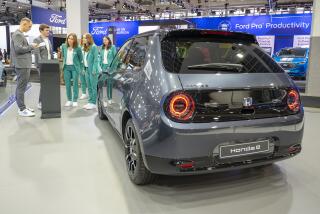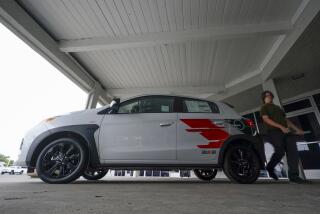Mazda’s New MP3 Moves to Make Music With the Street-Racer Crowd
Pushing a step beyond the competition with the notion that cars are becoming more and more like computers on wheels, Mazda Motor Corp. is bringing to market a version of its Protege sedan with what it says is the world’s first factory-installed MP3 player.
MP3 files--computer files that store digitally recorded music--are a hot item among younger consumers, especially the college crowd. Mazda, seeking to punch up its image as well as its sales, is aiming this model, called the Mazda MP3, squarely at that market.
“This appeals to people who like custom-tuning their cars,” said Charlie Hughes, president of Irvine-based Mazda North American Operations. “People spend much of their incomes getting their cars just the way they want; this is ready to go as is.”
The MP3 contains numerous appearance and performance parts, including racing wheels with special 17-inch Dunlop tires, and an “aero kit” that includes a rear spoiler, all for $18,500. Its 2-liter, 140-horsepower engine is slightly more powerful than the stock Protege ES’ 130-horsepower version.
And there’s a high-performance 280-watt Kenwood stereo with a gigantic sub-woofer in the trunk that’s as big as a duffel bag.
Only 1,500 MP3 models will be imported to the U.S. this year, heightening the exclusivity of a car Mazda wants to slip into the increasingly crowded street-cruising compact car market. Dominated by the Honda Accord and Civic for years, the segment is seeing competition from the Mitsubishi Eclipse, Toyota Celica and Subaru Impreza.
Bringing out a “pre-customized” car might not be the best way to market a car to hard-core customizers--”they usually want manufacturers to make something that’s all stripped down and fairly inexpensive so they can add their own equipment and personalize it,” said automotive marketing consultant Eric Noble of CarLab in Santa Ana.
“But it probably will attract attention in the youth group and might help get people thinking of Mazda as a manufacturer that might produce some vehicles they’d be interested in,” he said. “So it should be good for the Mazda image.” And that can’t hurt.
Mazda is best known in the U.S. for cars it introduced long ago: the Miata roadster and now-discontinued RX7 sports car with its unique rotary engine.
In recent years, though, the Japanese car maker--which Ford Motor Co. controls with a 33.4% ownership stake--has had difficulty carving out a distinct image in the U.S.
Mazda’s market share here is just 1.5%, and, while its U.S. sales rose 4.8% last year, it has fallen behind Mitsubishi Motor Corp. and in some months trails South Korea’s Hyundai Motor Co.
Now Mazda is trying to polish its image--and drum up investor interest. Next month it is holding an extensive presentation for Wall Street analysts at which it will detail future product plans that could include bringing vehicles such as the Premacy, a small minivan already sold in Europe and Asia, to the U.S. The company displayed the Premacy at the Chicago Auto Show in early February. Hughes said the five-passenger van, with a 2-liter, 130-horsepower engine, would probably be priced at less than $20,000 if it is sold here.
“Now we’re just checking consumer reaction, but we could do it for this market quickly,” Hughes said. “It appeals to an entirely different audience than the MPV,” he said, referring to Mazda’s large minivan that is already sold in the U.S.
Like the MP3, the Premacy is based on Mazda’s best-selling Protege platform.
So is the hatchback Protege Sport Wagon, which comes later this year as a 2002 model--in only one fully-equipped trim level--priced at $16,895.
Mazda hopes to further boost its image and sales with the RX8--which will bring back the rotary engine.
The RX8, shown as a nearly production-version concept at the Detroit Auto Show last month, is a sleek sports sedan with forward-opening rear doors for access to the back seat.
*
Times staff writer John O’Dell contributed to this report.





